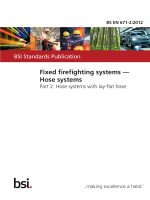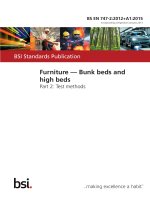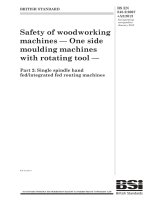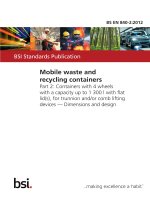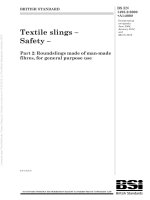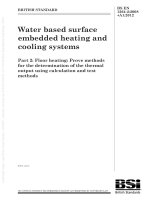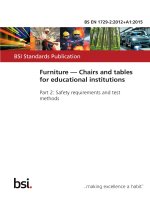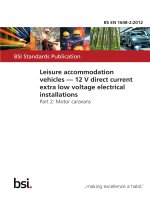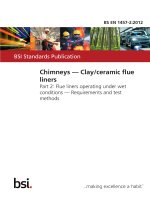Bsi bs en 61076 2 101 2012
Bạn đang xem bản rút gọn của tài liệu. Xem và tải ngay bản đầy đủ của tài liệu tại đây (2.81 MB, 64 trang )
BS EN 61076-2-101:2012
BSI Standards Publication
Connectors for
electronic equipment
— Product requirements
Part 2-101: Circular connectors —
Detail specification for M12
connectors with screw-locking
BRITISH STANDARD
BS EN 61076-2-101:2012
National foreword
This British Standard is the UK implementation of EN 61076-2-101:2012.
It is identical to IEC 61076-2-101:2012. It supersedes
BS EN 61076-2-101:2008, which is withdrawn.
The UK participation in its preparation was entrusted to Technical Committee
EPL/48, Electromechanical components and mechanical structures for
electronic equipment.
A list of organizations represented on this committee can be obtained on
request to its secretary.
This publication does not purport to include all the necessary provisions of a
contract. Users are responsible for its correct application.
© The British Standards Institution 2012
Published by BSI Standards Limited 2012
ISBN 978 0 580 71320 0
ICS 31.220.10
Compliance with a British Standard cannot confer immunity
from legal obligations.
This British Standard was published under the authority of the
Standards Policy and Strategy Committee on 31 August 2012.
Amendments issued since publication
Amd. No.
Date
Text affected
BS EN 61076-2-101:2012
EUROPEAN STANDARD
EN 61076-2-101
NORME EUROPÉENNE
August 2012
EUROPÄISCHE NORM
ICS 31.220.10
Supersedes EN 61076-2-101:2008
English version
Connectors for electronic equipment Product requirements Part 2-101: Circular connectors Detail specification for M12 connectors with screw-locking
(IEC 61076-2-101:2012)
Connecteurs pour équipements
électroniques - Exigences de produit Partie 2-101: Connecteurs circulaires Spécification particulière pour les
connecteurs M12 à vis
(CEI 61076-2-101:2012)
Steckverbinder für elektronische
Einrichtungen - Produktanforderungen Teil 2-101: Rundsteckverbinder Bauartspezifikation für Steckverbinder
M12 mit Schraubverriegelung
(IEC 61076-2-101:2012)
This European Standard was approved by CENELEC on 2012-05-25. CENELEC members are bound to comply
with the CEN/CENELEC Internal Regulations which stipulate the conditions for giving this European Standard
the status of a national standard without any alteration.
Up-to-date lists and bibliographical references concerning such national standards may be obtained on
application to the CEN-CENELEC Management Centre or to any CENELEC member.
This European Standard exists in three official versions (English, French, German). A version in any other
language made by translation under the responsibility of a CENELEC member into its own language and notified
to the CEN-CENELEC Management Centre has the same status as the official versions.
CENELEC members are the national electrotechnical committees of Austria, Belgium, Bulgaria, Croatia, Cyprus,
the Czech Republic, Denmark, Estonia, Finland, Former Yugoslav Republic of Macedonia, France, Germany,
Greece, Hungary, Iceland, Ireland, Italy, Latvia, Lithuania, Luxembourg, Malta, the Netherlands, Norway, Poland,
Portugal, Romania, Slovakia, Slovenia, Spain, Sweden, Switzerland, Turkey and the United Kingdom.
CENELEC
European Committee for Electrotechnical Standardization
Comité Européen de Normalisation Electrotechnique
Europäisches Komitee für Elektrotechnische Normung
Management Centre: Avenue Marnix 17, B - 1000 Brussels
© 2012 CENELEC -
All rights of exploitation in any form and by any means reserved worldwide for CENELEC members.
Ref. No. EN 61076-2-101:2012 E
BS EN 61076-2-101:2012
EN 61076-2-101:2012
Foreword
The text of document 48B/2279/FDIS, future edition 3 of IEC 61076-2-101, prepared by SC 48B
“Connectors” of IEC/TC 48 "Electromechanical components and mechanical structures for electronic
equipment" was submitted to the IEC-CENELEC parallel vote and approved by CENELEC as
EN 61076-2-101:2012.
The following dates are fixed:
•
latest date by which the document has
to be implemented at national level by
publication of an identical national
standard or by endorsement
(dop)
2013-02-25
•
latest date by which the national
standards conflicting with the
document have to be withdrawn
(dow)
2015-05-25
This document supersedes EN 61076-2-101:2008.
EN 61076-2-101:2012 includes the following significant technical changes with respect to
EN 61076-2-101:2008:
-
the drawings of some styles have been corrected;
-
a new style with maximum 17 poles, with A-coding, has been added, as new applications for the
industrial process measurement and control require a high number of poles in M12 circular
connectors. The existing styles and dimensions which were specified in EN 61076-2-101:2008 are
further applicable for the added interface dimension of the 17 poles versions;
-
removal of the type designation and ordering information, former Tables 6 and 7 have been
updated accordingly;
-
inclusion of the technical content of IEC/PAS 61076-2-108, which will be withdrawn after the
publication of this European Standard. The drawings have been updated and correction to the title
of Figure 9 was made.
Attention is drawn to the possibility that some of the elements of this document may be the subject of
patent rights. CENELEC [and/or CEN] shall not be held responsible for identifying any or all such
patent rights.
Endorsement notice
The text of the International Standard IEC 61076-2-101:2012 was approved by CENELEC as a
European Standard without any modification.
BS EN 61076-2-101:2012
EN 61076-2-101:2012
Annex ZA
(normative)
Normative references to international publications
with their corresponding European publications
The following documents, in whole or in part, are normatively referenced in this document and are
indispensable for its application. For dated references, only the edition cited applies. For undated
references, the latest edition of the referenced document (including any amendments) applies.
NOTE When an international publication has been modified by common modifications, indicated by (mod), the relevant EN/HD
applies.
Publication
Year
Title
EN/HD
Year
IEC 60050-581
2008
International Electrotechnical Vocabulary
(IEV) Part 581: Electromechanical components
for electronic equipment
-
-
IEC 60068-1
-
Environmental testing Part 1: General and guidance
EN 60068-1
-
IEC 60068-2-60
-
Environmental testing Part 2: Tests - Test Ke: Flowing mixed gas
corrosion test
EN 60068-2-60
-
IEC 60352
Series Solderless connections
EN 60352
Series
IEC 60423
2007
EN 60423
2007
IEC 60512
Series Connectors for electronic equipment - Tests EN 60512
and measurements
IEC 60512-1-100
-
Connectors for electronic equipment - Tests EN 60512-1-100
and measurements Part 1-100: General - Applicable publications
-
IEC 60529
1989
Degrees of protection provided by
enclosures (IP Code)
1991
1993
IEC 60664-1
-
Insulation coordination for equipment within EN 60664-1
low-voltage systems Part 1: Principles, requirements and tests
-
IEC 60998-2-1
-
Connecting devices for low-voltage circuits EN 60998-2-1
for household and similar purposes Part 2-1: Particular requirements for
connecting devices as separate entities with
screw-type clamping units
-
IEC 60999
EN 60999
Series Connecting devices - Electrical copper
conductors - Safety requirements for screwtype and screwless-type clamping units
IEC 61076-1
2006
Connectors for electronic equipment Product requirements Part 1: Generic specification
IEC 61984
-
Connectors - Safety requirements and tests EN 61984
-
ISO 1302
-
Geometrical Product Specifications (GPS) - EN ISO 1302
Indication of surface texture in technical
product documentation
-
Conduit systems for cable management Outside diameters of conduits for electrical
installations and threads for conduits and
fittings
EN 60529
+ corr. May
EN 61076-1
Series
Series
2006
BS EN 61076-2-101:2012
61076-2-101 © IEC:2012
CONTENTS
1
Scope . ............................................................................................................................................. 8
2
Normative references . .................................................................................................................. 8
3
Technical information . .................................................................................................................. 9
3.1
3.2
4
Terms and definitions . ........................................................................................................ 9
Recommended method of termination . ............................................................................ 9
3.2.1 General . .................................................................................................................. 9
3.2.2 Number of contacts or contact cavities . ........................................................... 10
3.3 Ratings and characteristics ............................................................................................. 10
3.4 Marking . ............................................................................................................................. 10
3.5 Safety aspects. .................................................................................................................. 10
Dimensional information ............................................................................................................. 11
4.1
4.2
General . ............................................................................................................................. 11
Survey of styles and variants . ......................................................................................... 11
4.2.1 Fixed connectors . ................................................................................................ 11
4.2.2 Free connectors . ................................................................................................. 22
4.3
5
Interface dimensions . ....................................................................................................... 27
4.3.1 Pin front view A-coding . ...................................................................................... 27
4.3.2 Pin front view B-coding . ...................................................................................... 32
4.3.3 Pin front view C-coding . ...................................................................................... 33
4.3.4 Pin front view D-coding . ...................................................................................... 36
4.3.5 Pin front view P-coding . ...................................................................................... 37
4.4 Engagement (mating) information ................................................................................... 38
4.5 Gauges . ............................................................................................................................. 40
Characteristics . ........................................................................................................................... 41
5.1
5.2
6
Climatic category ............................................................................................................... 41
Electrical characteristics . ................................................................................................. 41
5.2.1 Rated voltage – Rated impulse voltage – Pollution degree . .......................... 41
5.2.2 Voltage proof . ....................................................................................................... 42
5.2.3 Current-carrying capacity.................................................................................... 43
5.2.4 Contact resistance . .............................................................................................. 43
5.2.5 Insulation resistance ............................................................................................ 44
5.3 Mechanical characteristics . ............................................................................................. 44
5.3.1 IP degree of protection . ...................................................................................... 44
5.3.2 Mechanical operation . ........................................................................................ 44
5.3.3 Insertion and withdrawal forces . ....................................................................... 44
5.3.4 Contact retention in insert ................................................................................... 44
5.3.5 Polarizing method . ............................................................................................... 45
5.3.6 Vibration (sinusoidal) . ......................................................................................... 45
5.3.7 Pressure differential ............................................................................................ 45
Test schedule . ............................................................................................................................. 45
6.1
6.2
6.3
6.4
General . ............................................................................................................................. 45
Arrangement for contact resistance measurements . ................................................... 46
Arrangement for dynamic stress tests (vibration) ......................................................... 46
Test schedule . ................................................................................................................... 48
BS EN 61076-2-101:2012
61076-2-101 © IEC:2012
6.4.1 Test
6.4.2 Test
6.4.3 Test
6.4.4 Test
6.4.5 Test
6.4.6 Test
6.4.7 Test
Annex A (informative)
group P – Preliminary . ............................................................................... 48
group AP – Dynamic/ Climatic . .................................................................. 49
group BP – Mechanical endurance . .......................................................... 52
group CP – Electrical load . ....................................................................... 54
group DP – Chemical resistivity . .............................................................. 55
group EP – Connection method tests . ..................................................... 55
group FP – Electrical transmission requirements . ................................. 56
Diameter of the female connector body . ................................................. 57
Annex B (informative) Steel conduit thread, sizes . ...................................................................... 58
Figure 1 – Tube insert, male contacts, mounting without thread (thread on tube) . .................. 12
Figure 2 – Tube insert, male contacts, mounting with thread M12 × 1 ....................................... 12
Figure 3 – Fixed connector, male contacts, mounting with thread M12 × 1, square
flange front mounting . ........................................................................................................................ 13
Figure 4 – Fixed connector, male contacts, mounting with thread M12 × 1, with wire
ends, single hole mounting thread M16 × 1,5 . ............................................................................... 14
Figure 5 – Fixed connector, male contacts, mounting with thread M12 × 1, with wire
ends, single hole mounting thread M20 × 1,5 . ............................................................................... 14
Figure 6 – Fixed connector, male contacts, mounting with thread M12 × 1 with wire
ends, single hole mounting thread M16 × 1,5, mounting orientation . .......................................... 15
Figure 7 – Fixed connector, male contacts, mounting with thread M12 × 1, with wire
ends, single hole mounting thread M20 × 1,5, mounting orientation . .......................................... 15
Figure 8 – Fixed connector, glass to metal seal, square flange front mounting, male
contacts . .............................................................................................................................................. 16
Figure 9 – Fixed connector, glass to metal seal, single hole front mounting, male
contacts . .............................................................................................................................................. 17
Figure 10 – Fixed connector, glass to metal seal, jam nut rear mounting, male
contacts . .............................................................................................................................................. 18
Figure 11 – Fixed connector, glass to metal seal, through flange mounting, male
contacts . .............................................................................................................................................. 19
Figure 12 – Fixed connector, female contacts, mounting with thread M12 × 1, with wire
ends, single hole mounting thread M16 × 1,5 . ............................................................................... 19
Figure 13 – Fixed connector, female contacts, mounting with thread M12 × 1, with wire
ends, single hole mounting thread M20 × 1,5 . ............................................................................... 20
Figure 14 – Fixed connector, female contacts, mounting with thread M12 × 1, with wire
ends, single hole mounting thread M16 × 1,5, mounting orientation . .......................................... 21
Figure 15 – Fixed connector, female contacts, mounting with thread M12 × 1, with wire
ends, single hole mounting thread M20 × 1,5, mounting orientation . .......................................... 21
Figure 16 – Rewireable connector, male contacts, straight version, with locking nut . ............. 22
Figure 17 – Rewireable connector, male contacts, right angled version, with locking nut. ...... 23
Figure 18 – Non-rewireable connector, male contacts, straight version, with locking nut . ...... 23
Figure 19 – Non-rewireable connector, male contacts, right angled version, with
locking nut . .......................................................................................................................................... 24
Figure 20 – Non-rewireable connector, male contacts, right angled higher version, with locking
nut . ....................................................................................................................................................... 24
Figure 21 – Rewireable connector, female contacts, straight version, with locking nut . ......... 25
Figure 22 – Rewireable connector, female contacts, right angled version, with locking nut .... 25
Figure 23 – Non-rewireable connector, female contacts, straight version, with locking nut .... 26
BS EN 61076-2-101:2012
61076-2-101 © IEC:2012
Figure 24 – Non-rewireable connector, female contacts, right angled version, with
locking nut . .......................................................................................................................................... 26
Figure 25 – Pin front view A-coding, up to 12 ways . ..................................................................... 27
Figure 26 – Pin front view A-coding, 13 up to 17 ways ................................................................. 28
Figure 27 – Contact position A-coding front view .......................................................................... 30
Figure 28 – Pin front view B-coding . ............................................................................................... 32
Figure 29 – Contact position B-coding front view .......................................................................... 32
Figure 30 – Pin front view 3 way with C-coding . ............................................................................ 33
Figure 31 – Pin front view 4 way with C-coding . ............................................................................ 33
Figure 32 – Pin front view 5 way with C-coding . ............................................................................ 34
Figure 33 – Pin front view 6 way with C-coding . ............................................................................ 34
Figure 34 – Contact position C-coding front view .......................................................................... 35
Figure 35 – Pin front view D-coding . ............................................................................................... 36
Figure 36 – Contact position D-coding front view .......................................................................... 36
Figure 37 – Pin front view P-coding . ............................................................................................... 37
Figure 38 – Contact position P-coding front view .......................................................................... 37
Figure 39 – Engagement (mating) information . .............................................................................. 38
Figure 40 – Gauge dimensions . ....................................................................................................... 41
Figure 41 – Contact resistance arrangement . ................................................................................ 46
Figure 42 – Dynamic stress test arrangement . .............................................................................. 47
Figure A.1 – Diameter of the female connector body . ................................................................... 57
Figure B.1 – Dimensions Pg thread . ................................................................................................ 58
Table 1 – Ratings of connectors . ...................................................................................................... 10
Table 2 – Styles of fixed connectors . .............................................................................................. 11
Table 3 – Styles of free connectors . ................................................................................................ 22
Table 4 – Connectors dimensions in mated and locked position . ................................................ 39
Table 5 – Gauges . ............................................................................................................................. 41
Table 6 – Climatic category .............................................................................................................. 41
Table 7 – Rated voltage – Rated impulse voltage – Pollution degree ........................................ 42
Table 8 – Voltage proof. .................................................................................................................... 43
Table 9 – Number of mechanical operations . ................................................................................ 44
Table 10 – Insertion and withdrawal forces .................................................................................... 44
Table 11 – Number of test specimens ............................................................................................. 46
Table 12 – Test group P . .................................................................................................................. 48
Table 13 – Test group AP . ................................................................................................................ 49
Table 14 – Test group BP . ................................................................................................................ 52
Table 15 – Test group CP . ................................................................................................................ 54
Table 16 – Test group DP . ................................................................................................................ 55
Table 17 – Test group EP . ................................................................................................................ 55
Table 18 – Test group FP . ................................................................................................................ 56
Table A.1 – Diameter of the female connector body, dimension x . ............................................ 57
Table B.1 – Dimensions . ................................................................................................................... 59
BS EN 61076-2-101:2012
61076-2-101 © IEC:2012
IEC SC 48B – Connectors
IEC 61076-2-101 Ed. 3.0
Specification available from:
IEC General secretariat
or from the addresses shown on the inside cover.
ELECTRONIC COMPONENTS
DETAIL SPECIFICATION in accordance with IEC 61076-1
Circular connectors
M12
2 to 17 way
Male and female contacts
Male and female connectors
Rewireable – Non-rewireable
Free cable connectors
Straight and right angle connectors
Fixed connectors
Fixed connectors with glass to metal
seals (pin contacts only)
Flange mounting
Single hole mounting
IEC 2336/03
Pin sockets
BS EN 61076-2-101:2012
61076-2-101 © IEC:2012
–8–
CONNECTORS FOR ELECTRONIC EQUIPMENT –
PRODUCT REQUIREMENTS –
Part 2-101: Circular connectors –
Detail specification for M12 connectors with screw-locking
1
Scope
This part of IEC 61076 describes M12 circular connectors typically used for industrial process
measurement and control. These connectors consist of fixed and free connectors either
rewireable or non-rewireable, with screw-locking. The connectors with glass to metal seal are
fixed connectors only which consist of fixed glass to metal sealed styles with rewireable male
contacts and are intermateable with corresponding free connectors according to this
International Standard. Male connectors have round contacts ∅ 0,6 mm, ∅ 0,76 mm, ∅ 0,8
mm and ∅ 1,0 mm.
The different codings prevent the mating of these coded male or female connectors to any
other interfaces and cross-mating between the different codings.
NOTE
2
M12 is the dimension of the thread of the screw-locking mechanism of these circular connectors.
Normative references
The following documents, in whole or in part, are normatively referenced in this document and
are indispensable for its application. For dated references, only the edition cited applies. For
undated references, the latest edition of the referenced document (including any
amendments) applies.
IEC 60050-581: 2008, International Electrotechnical
Electromechanical components for electronic equipment
Vocabulary
(IEV)
–
Part
581:
IEC 60068-1, Environmental testing – Part 1: General and guidance
IEC 60068-2-60, Environmental testing – Part 2: Tests –Test Ke: Flowing mixed gas
corrosion test
IEC 60352 (all parts), Solderless connections
IEC 60423:2007, Conduit systems for cable management – Outside diameters of conduits for
electrical installations and threads for conduits and fittings
IEC 60512 (all parts), Connectors for electronic equipment – Tests and measurements
IEC 60512-1-100, Connectors for electronic equipment – Tests and measurements – Part 1100: General – Applicable publications
IEC 60529:1989, Degrees of protection provided by enclosures (IP code)
IEC 60664-1, Insulation coordination for equipment within low-voltage systems – Part 1:
Principles, requirements and tests
BS EN 61076-2-101:2012
61076-2-101 © IEC:2012
–9–
IEC 60998-2-1, Connecting devices for low-voltage circuits for household and similar
purposes – Part 2-1: Particular requirements for connecting devices as separate entities with
screw-type clamping units
IEC 60999 (all parts), Connecting devices – Electrical copper conductors – Safety
requirements for screw-type and screwless-type clamping units
IEC 61076-1:2006, Connectors for electronic equipment – Product requirements – Part 1:
Generic specification
IEC 61984, Connectors – Safety requirements and tests
ISO 1302: Technical drawings – Methods of indicating surface texture
3
Technical information
3.1
Terms and definitions
For the purposes of this document, terms and definitions from IEC 60050-581 as well as the
following apply.
3.1.1
mounting orientation
circular mounting position of the connector in relation to the polarization of the mating
interface
NOTE Where the free connector has an angled cable entry (as opposed to an in-line cable entry), the angle
between the cable entry direction and the polarization keyway should be specified.
3.1.2
glass to metal seal
a form of construction whereby the connector contacts are housed in a glass insert which is
inside a metal connector shell so as to form a connector with a hermetic seal which may be
used to isolate differing environments
3.1.3
matched glass to metal seal
a form of construction whereby the thermal expansion characteristics of the glass, the metallic
contacts, and the connector shell are similar and the seal between the glass and the metal is
formed by a chemical bond
3.1.4
compression glass to metal seal
a form of construction whereby due to the its higher coefficient of expansion the shell
contracts around the glass during the solidification phase of manufacture applying a
compression force to the glass insert so as to form a seal
3.2
3.2.1
Recommended method of termination
General
The contact terminations shall be of the following types: screw, crimp, insulation piercing,
insulation displacement, press-in or solder. For the male connectors having a glass to metal
seal the recommended contact terminations are crimp, eyelet, solder, PCB and rounded.
NOTE 1 eyelet – the termination end is flattened and pierced with a hole to provide both mechanical retention of
the wire as well as solder attachment.
NOTE 2
rounded – terminal post with rounded (domed) end.
BS EN 61076-2-101:2012
61076-2-101 © IEC:2012
– 10 –
NOTE 3
3.2.2
PCB – termination spills suitable for insertion into printed circuits.
Number of contacts or contact cavities
A-coding
B-coding
C-coding
D-coding
P-coding
3.3
2
5
3
4
5
to 17 contacts
contacts
to 6 contacts
contacts
contacts (4+PE)
Ratings and characteristics
For the ratings, see Table 1.
Table 1 – Ratings of connectors
Coding
Style
Contacts
Rated voltage
Rated current
a.c. or d.c.
A
V
5 way
A-coding
250
5
60
4
8 way
6 to 8
30
2
12 way
9 to 12
30
1,5
17 way
13 to 17
30
1,5
5 way
5
60
4
3 way (2 + PE)
3 (2 + PE)
250
4
4 way (3 + PE)
4 (3 + PE)
250
4
5 way (4 + PE)
5 (4 + PE)
60
2
6 way (5 + PE)
6 (5 + PE)
30
2
D-coding
4 way
4
250
P-coding
5 way (4 + PE)
5 (4 + PE)
60
B-coding
C-coding
a
2 to 4
4
a
4
The M12 connectors with D-coding (4 way) are tested for use with frequencies up to 100 MHz.
Insulation resistance
: 10 8 Ω min.
Climatic category
: see Table 6
Contact spacing
: see Clause 5
3.4
Marking
The marking of the connector and the package shall be in accordance with 2.7 of
IEC 61076-1.
3.5
Safety aspects
For safety aspects IEC 61984 shall be considered unless otherwise specified.
BS EN 61076-2-101:2012
61076-2-101 © IEC:2012
4
– 11 –
Dimensional information
4.1
General
Throughout this standard dimensions are in mm. Drawings are shown in the first angle
projection. The shape of the connectors may deviate from those given in the following
drawings as long as the specified dimensions are not influenced.
Missing dimensions shall be chosen according to common characteristics and intended use.
4.2
Survey of styles and variants
For all connector styles with cables, the length L of the cable shall be agreed between
manufacturer and user. For connector styles with glass to metal seal the length E of the
contacts shall be agreed between manufacturer and user.
For interface dimensions see 4.3.
The interface dimensions of the female styles shall be chosen according to the common
characteristics of the male styles.
For reliable intermateability, the dimensions of the female connector body as detailed in
Annex A have to be met.
4.2.1
Fixed connectors
Table 2 shows styles of fixed connectors.
Table 2 – Styles of fixed connectors
Style
Description
AM
Tube insert, male contacts, mounting without thread
BM
Tube insert, male contacts, mounting with thread M12 × 1
DM
Fixed connector, male contacts, mounting with thread M12 × 1, square flange front mounting
EM
Fixed connector, male contacts, mounting with thread M12 × 1, with wire ends,
single hole mounting M16 × 1,5
FM
Fixed connector, male contacts, mounting with thread M12 × 1, with wire ends,
single hole mounting M20 × 1,5
GM
Fixed connector, male contacts, mounting with thread M12 × 1, with wire ends,
single hole mounting M16 × 1,5, mounting orientation
HM
Fixed connector, male contacts, mounting with thread M12 × 1, with wire ends,
single hole mounting M20 × 1,5, mounting orientation
WM
Fixed connector, glass to metal seal, square flange front mounting, male contacts
XM
Fixed connector, glass to metal seal, single hole front mounting, male contacts
YM
Fixed connector, glass to metal seal, jam nut rear mounting, male contacts
ZM
Fixed connector, glass to metal seal, through flange mounting, male contacts
EF
Fixed connector, female contacts, with wire ends, single hole mounting M16 × 1,5
FF
Fixed connector, female contacts, with wire ends, single hole mounting M20 × 1,5
GF
Fixed connector, female contacts, with wire ends, single hole mounting M16 × 1,5, mounting orientation
HF
Fixed connector , female contacts , with wire ends , single hole mounting M20 × 1,5, mounting orientation
NOTE For new connectors according to this International Standard, Pg screw threads according to DIN 46320
(withdrawn) should not be applicable. For information on Pg threads, see Annex B.
– 12 –
4.2.1.1
BS EN 61076-2-101:2012
61076-2-101 © IEC:2012
Style AM
Figure 1 shows a tube insert, with male contacts and a mounting with thread (thread on tube).
Figure 1 – Tube insert, male contacts, mounting without thread (thread on tube)
4.2.1.2
Style BM
Figure 2 shows a tube insert, with male contacts and a mounting with thread M12 × 1.
Figure 2 – Tube insert, male contacts, mounting with thread M12 × 1
BS EN 61076-2-101:2012
61076-2-101 © IEC:2012
4.2.1.3
– 13 –
Style DM
Figure 3 shows a fixed connector, with male contacts, mounting with thread M12 × 1 and a
square flange front mounting.
Figure 3 – Fixed connector, male contacts, mounting with thread M12 × 1,
square flange front mounting
– 14 –
4.2.1.4
BS EN 61076-2-101:2012
61076-2-101 © IEC:2012
Style EM
Figure 4 shows a fixed connector, with male contacts, mounting with thread M12 × 1, with wire
ends and a single hole mounting thread M16 × 1,5.
23 max.
L = length of wire ends
13 max.
∅18,2 max.
17
M16 × 1,5
Position free to flange
Sealing
IEC 1145/08
Figure 4 – Fixed connector, male contacts, mounting with thread M12 × 1,
with wire ends, single hole mounting thread M16 × 1,5
4.2.1.5
Style FM
Figure 5 shows a fixed connector, with male contacts, mounting with thread M12 × 1, with wire
ends and a single hole mounting thread M20 × 1,5.
L = length of wire ends
13 max.
∅26,2 max.
M20 × 1,5
Position free to flange
23
23 max.
Sealing
IEC 1146/08
Figure 5 – Fixed connector, male contacts, mounting with thread M12 × 1,
with wire ends, single hole mounting thread M20 × 1,5
BS EN 61076-2-101:2012
61076-2-101 © IEC:2012
4.2.1.6
– 15 –
Style GM
Figure 6 shows a fixed connector, male contacts, mounting with thread M12 × 1 with wire
ends, a single hole mounting thread M16 × 1,5 and a mounting orientation.
Figure 6 – Fixed connector, male contacts, mounting with thread M12 × 1 with wire
ends, single hole mounting thread M16 × 1,5, mounting orientation
4.2.1.7
Style HM
Figure 7 shows a fixed connector, with male contacts, a mounting with thread M12 × 1, with
wire ends, a single hole mounting thread M20 × 1,5 and a mounting orientation.
Figure 7 – Fixed connector, male contacts, mounting with thread M12 × 1, with wire
ends, single hole mounting thread M20 × 1,5, mounting orientation
BS EN 61076-2-101:2012
61076-2-101 © IEC:2012
– 16 –
4.2.1.8
Style WM
Figure 8 shows a fixed connector, with glass to metal seal, square flange front mounting, male
contacts.
20,6
15,6
12,7 ± 0,25
,
0,1 A
,
E1)
A
15,1
(2 ×)
3,40
∅ 3,20
Position free
to flange
Panel cut out
15,1
0,1 A
∅
(2 ×)
,12,10
12,15
A
∅
3,30
3,10
(4×)
IEC 410/12
1)
E
NOTE
length of contacts
Type of contact shall be crimp, eyelet, solder, PCB or rounded.
Figure 8 – Fixed connector, glass to metal seal, square
flange front mounting, male contacts
BS EN 61076-2-101:2012
61076-2-101 © IEC:2012
4.2.1.9
– 17 –
Style XM
Figure 9 shows a fixed connector, with glass to metal seal, single hole front mounting
male contacts, which is intended to be welded or soldered into a panel or bulkhead.
14
12 ± 0,25
E
1)
∅ 22
Position
Position free
free
to
to flange
flange
IEC 411/12
1)
E
NOTE
length of contacts
Type of contact shall be crimp, eyelet, solder, PCB or rounded.
Figure 9 – Fixed connector, glass to metal seal, single hole
front mounting, male contacts
BS EN 61076-2-101:2012
61076-2-101 © IEC:2012
– 18 –
4.2.1.10
Style YM
Figure 10 shows a fixed connector, with glass to metal seal, jam nut rear mounting, male
contacts.
24
17,6 ± 0,25
Sealing
E
1)
19
M14 × 1
Position free
to flange
13,77
13,51
Panel cut out
14,38
∅
14,12
IEC 412/12
1)
E
NOTE
length of contacts
Type of contact shall be crimp, eyelet, solder, PCB or rounded.
Figure 10 – Fixed connector, glass to metal seal,
jam nut rear mounting, male contacts
BS EN 61076-2-101:2012
61076-2-101 © IEC:2012
4.2.1.11
– 19 –
Style ZM
Figure 11 shows a fixed connector, with glass to metal seal, through flange mounting, male
contacts.
27,5
15,5 ± 0,25
19
E1)
17
M14 × 1
Sealing
Position free
to flange
IEC 413/12
1)
E
NOTE
length of contacts
Type of contact shall be crimp, eyelet, solder, PCB or rounded.
Figure 11 – Fixed connector, glass to metal seal, through flange
mounting, male contacts
4.2.1.12
Style EF
Figure 12 shows a fixed connector, female contacts, a mounting with thread M12 × 1, with
wire ends and a single hole mounting thread M16 × 1,5.
Figure 12 – Fixed connector, female contacts, mounting with thread M12 × 1,
with wire ends, single hole mounting thread M16 × 1,5
– 20 –
4.2.1.13
BS EN 61076-2-101:2012
61076-2-101 © IEC:2012
Style FF
Figure 13 shows a fixed connector, with female contacts, a mounting with thread M12 × 1,
with wire ends and a single hole mounting thread M20 × 1,5.
Figure 13 – Fixed connector, female contacts, mounting with thread M12 × 1,
with wire ends, single hole mounting thread M20 × 1,5
BS EN 61076-2-101:2012
61076-2-101 © IEC:2012
4.2.1.14
– 21 –
Style GF
Figure 14 shows a fixed connector, with female contacts, a mounting with thread M12 × 1,
with wire ends, a single hole mounting thread M16 × 1,5 and a mounting orientation.
25 max.
13 max.
L = length of wire ends
∅18,2 max.
6 ± 0,3
Fixing nut
17
M16 × 1,5
Sealing
Position free to flange
IEC 1151/08
Figure 14 – Fixed connector, female contacts, mounting with thread M12 × 1,
with wire ends, single hole mounting thread M16 × 1,5, mounting orientation
4.2.1.15
Style HF
Figure 15 shows a fixed connector, with female contacts, mounting with thread M12 × 1, with
wire ends, a single hole mounting thread M20 × 1,5 and a mounting orientation.
25 max.
∅26,2 max.
Sealing
6 ± 0,3
Fixing nut
23
M20 × 1,5
13 max.
L = length of wire ends
Position free to flange
IEC 1152/08
Figure 15 – Fixed connector, female contacts, mounting with thread M12 × 1,
with wire ends, single hole mounting thread M20 × 1,5, mounting orientation
BS EN 61076-2-101:2012
61076-2-101 © IEC:2012
– 22 –
4.2.2
Free connectors
Table 3 shows styles of free connectors.
Table 3 – Styles of free connectors
Style
a
Description
a
JM
Rewireable connector, male contacts, straight version, with locking nut
KM
Rewireable connector, male contacts, right angled version, with locking nut
a
LM
Non-rewireable connector, male contacts, straight version, with locking nut
a
MM
Non-rewireable connector, male contacts, right angled version, with locking nut
NM
Non-rewireable connector, male contacts, right angled higher version, with locking nut
JF
Rewireable connector, female contacts, straight version, with locking nut
KF
Rewireable connector, female contacts, right angled version, with locking nut
LF
Non-rewireable connector, female contacts, straight version, with locking nut
MF
Non-rewireable connector, female contacts, right angled version, with locking nut
Knurled ring or hexagonal ring upon agreement.
4.2.2.1
Style JM
Figure 16 shows a rewireable connector, with male contacts, a straight version with locking
nut.
65 max.
∅21 max.
1)
Cable outlet
2)
IEC 2348/03
1)
Cable outlet alternatively inside.
2)
Cable outlet diameter range upon agreement.
Figure 16 – Rewireable connector, male contacts, straight version, with locking nut
BS EN 61076-2-101:2012
61076-2-101 © IEC:2012
4.2.2.2
– 23 –
Style KM
Figure 17 shows a rewireable connector, with male contacts, a right angled version with
locking nut.
1)
Cable outlet alternatively inside.
2)
Cable outlet diameter range upon agreement.
Figure 17 – Rewireable connector, male contacts,
right angled version, with locking nut
4.2.2.3
Style LM
Figure 18 shows a non-rewireable connector, with male contacts and a straight version with
locking nut.
Figure 18 – Non-rewireable connector, male contacts,
straight version, with locking nut

